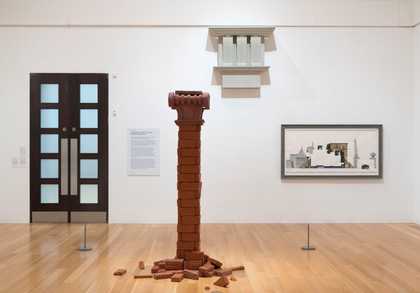In different ways, Edward Allington and Pablo Bronstein both take inspiration from classical architecture in their work
Three of Allington’s sculptures from the 1980s have been brought together with a recent work on paper by Bronstein. Working almost 30 years apart, both artists engage with history through a contemporary lens. They contrast the architectural forms and ideals of ancient Greece and Rome with the modern world. Through this process, they explore a clash of traditions and philosophies, old and new.
Allington was interested in ideas of authenticity and imitation. He was particularly fascinated by the ways in which the remnants of ancient Greece and Rome were presented in modern times. In the 1970s he visited the Parthenon, the temple at the heart of ancient Athens. ‘I found it impossible to see the real Parthenon for the souvenirs and distorted depictions of it’, he recalled. ‘Finally I decided that the “real thing” just wasn’t there.’ Reflecting this experience, Allington used elements of classical architecture in his work, while removing their context and practical purpose. The results are often playful and absurd.
Bronstein sees himself as looking back at some of the concerns of Allington’s generation, especially around architecture. His drawings fuse the past with imaginative fiction. Cross Section of the Via Appia in Late Antiquity is a recreation of one of the oldest and most important roads in Rome. Bronstein has described the drawing as ‘a tableau of remnants of architectural styles from many periods and places’. His version of the ancient road explores how architecture is used to express ideas of power, wealth and status. This relates to Bronstein’s awareness of the impact of architecture on our minds and bodies and the changing role of public and private space.
Tate Britain

